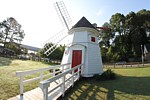
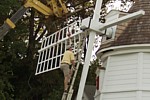



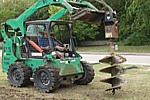

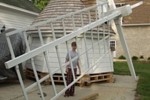
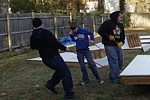

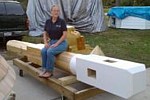
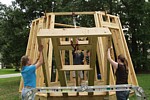


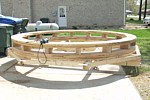
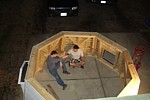
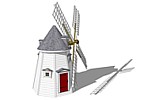
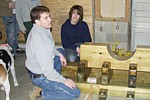
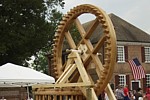
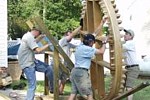
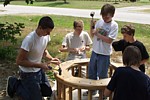
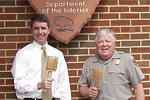
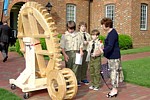
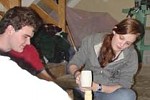
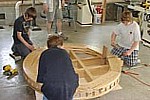


The Yorktown Windmill Project was conceived as a cooperative effort between the Yorktown Foundation, the County of York and the Colonial National Historical Park as an effort to reconstruct William Buckner's Mill in Yorktown, Virginia. The project was launched in January of 2008 with the objective of rebuilding the mill and developing an effective interpretive program that will allow future generations to appreciate the imagination and ingenuity that characterized America's Wooden Engineering Age.


|
2014 Annual Maintenance
September 30, 2014
A few minor touch-ups and some new trim get Miss Evelyn
ready for Yorktown Day.
|

|
Installing the Sails
October 9th, 2011
Scott Hartman brings the construction forklift to the site one
last time to help install the sails.
|

|
Assembling the Mill Tower
September 30, 2011
When the time came to assemble the mill,
Hampton Roads Crane and Rigging
brought the right tool for the job.
|

|
Moving to the Site
September 13 - 19, 2011
Over the course of a week of evenings, volunteers
gathered to relocate the windmill from the shop in Seaford to the Yorktown
Waterfront.
|

|
Installing the Foundation
September 9, 2011
C.A. Barrs and
Rappahannock Concrete come out
to help and pour a great foundation for the Yorktown Windmill.
|

|
Groundbreaking
September 2, 2011
Closing in on the finish line, we broke ground at
the site adjacent to the Watermen's Museum and prepared for the installation
of the pilings.
|

|
Hurricane Irene
August 27, 2011
Into every life some rain must fall...
|

|
Fabrication of the Common Sails
March 1, 2011
Early in the winter of 2011, the windmill
team works together to build the windmill sails and prepare
them for installation by the summer of 2011.
|

|
Relocating the First Floor
December 2010
Although it wasn't originally part of the plan,
our volunteers stepped in to relocate the mill for the Christmas
holidays.
|

|
Trimming the Cap and Installing the Stocks
November 16th, 2010
The installation of the stocks brings the true
form of the windmill into focus.
|

|
Fitting the Windshaft
October 31st, 2010
As summer gives way to fall, the windshaft is the
next element of the windmill that enters construction.
|

|
Fabrication of the First Level
September 1st, 2010
A long summer's project, the first level of the
Yorktown Windmill is as heavy as it is strong.
|

|
Yorktown Windmill Floor System
June 7th, 2010
The Yorktown Windmill floor system, while still portable
is remarkably strong and stable.
|

|
The Yorktown Windmill Cap
June 1st, 2010
Perhaps the most ambitious component of the project,
the cap of the Yorktown Windmill is both traditional and elegant.
|

|
The Dead Curb
May 1st, 2010
While certainly not one of the most glamorous elements
of the project, the curb is an essential element for the operation of the mill.
|

|
Construction and Assembly of the Second Level
April 1st, 2010
An exciting return to construction, the second level of
the Yorktown Windmill is the housing for the gear system and brake wheel.
|

|
Final Design of the Yorktown Windmill
April 17th, 2010
How the Yorktown Windmill design changed from
being a fixed structure to being a completely portable design.
|

|
Construction of the Neck Bearing Assembly
January 11th, 2009
Despite cold weather and dark nights, our intrepid
volunteers came together to build the neck bearing assembly --- our first
major achievement of the new year.
|

|
Yorktown Windmill Project on Independence Day
July 4th, 2008
After months of preparation, the Yorktown Windmill
gears make their debut at the Independence Day Celebration in Yorktown
Virginia.
|

|
Construction of the Gear Display Stand
July 3rd, 2008
Only hours before Independence Day, our volunteers
went the extra mile to build a display stand for the Yorktown Windmill's
gears.
|

|
Assembly of the Wallower
June 14th, 2008
Members of Boy Scout Troop 123 and the Fifes and Drums
of York Town unite in Seaford to perform the final assembly of the
wallower gear.
|

|
Assembly of the Brake Wheel
May 28th, 2008
Congressman Rob Wittman and Superintendent Dan
Smith join the project team to complete the assembly of Yorktown
Windmill's brake wheel... the largest gear in the mill.
|

|
Presentation of the First Gears
May 20th, 2008
Boy Scouts from Troop 123 of Seaford, VA present the
first set of windmill gears at the May meeting of the Yorktown Foundation.
|

|
Assembly of the Stone Nuts
May 12th, 2008
A team of volunteers of all ages worked together to
perform final assembly on the Yorktown Windmill's stone nuts; a pair of
lantern pinion gears that drive the millstones.
|

|
Great Spur Wheel Construction Completed
April 19th, 2008
On April 19th, 2008 a team of volunteers completed
assembly of the first major gear of the Yorktown Windmill.
|

Built in 1711 by William Buckner, the Yorktown Windmill was a guidepost
on the York River for nearly two centuries. After retiring from his post
as Surveyor General of Virginia, Buckner purchased the pointed bluff
just above Yorktown from John Lewis of Gloucester for the express purpose
of building a mill to grind corn. Although Buckner died only five years
later, the mill continued to provide most of the flour for York County
throughout the 18th and 19th Centuries.
What did the windmill look like?
Although the mill was never photographed there are a number of paintings,
engravings and sketches that show the windmill and it's location through
the years.
Where was the windmill located?
During both the American Revolution and the American Civil War, Yorktown
took the center stage of history during key campaigns. Military and logistical
maps from both periods show the Yorktown Windmill as a landmark... although,
interestingly, the mill appears to have moved westward across Windmill Creek.
When was the windmill destroyed?

The project continuous to make dramatic progress and we're working diligently to have the building dedication on Yorktown Day - October 19th, 2011.

The following documentation has been developed as part of the project. Additional diagrams, plans and specifications will be provided as they are developed.

The best way of determining how an old mill should be built, is to examine other old mills. Fortunately, the Historic American Building Survey and the Historic American Engineering Record projects have done much of the work already. These projects were instituted by the National Park Service in the early 20th Century to document many of the ancient buildings still standing in the United States. These documents are currently maintained as part of the Library of Congress's American Memory Project and provide an extraordinary level of detail regarding the construction of American windmills.
| The Beebe Windmill - Bridgehampton, Long Island, New York |
|
|
| The Chatham Windmill - Barnstable County, Cape Cod, Massachussetts |
|
|
| The Eastham Windmill - Barnstable County, Cape Cod, Massachussetts |
|
|
| The Gardiner's Island Windmill - Gardiner's Island, New York |
|
|
| The Heideman Mill - Addison, Illinois |
|
|
| The Hook Mill - East Hampton, Long Island, New York |
|
|
| The Old Windmill - Nantucket, Massachusetts |
|
|
| The Windmill at Water Mill - Water Mill, Long Island, New York |
|
|

| Project Planning | Ongoing | |||||||||||||||||||||||||||||||||||||||||||||||||||||||||||||||||||||||||||||||||||||||||||||||||||||||||||||||||||||||||||||||||||||||||||||||||||||||||||||||||||||||||||||
|
Assembly of the Great Spur Wheel
|
April 19th, 2008
|
Assembly of the Stone Nuts
|
May 12th, 2008
|
Assembly of the Brake Wheel
|
May 28th, 2008
|
Assembly of the Wallower
|
June 14th, 2008
|
Construction of the Gear Display Stand
|
July 3rd, 2008
|
Construction of the Neck Bearing Assembly
|
January 11th, 2009
|
Construction of the Second Level
|
April 1st, 2010
|
Construction of the Dead Curb
|
May 1st, 2010
|
Construction of the Windmill Cap
|
June 1st, 2010
|
Construction of the Windmill Floor
|
June 7th, 2010
|
Construction of the First Level
|
September 1st, 2010
|
Construction of the Windshaft
|
October 31st, 2010
|
Installation of the Cap Trim and Stocks
|
November 16th, 2010
|
Relocating the First Floor
|
December, 2010
| | ||||||||||||||||||||||||||||||||||||||||||||||||||||||||||||||||||||||||||||||||||||||||||||||||||||||||||||||||||||||||||||||||||||||||||||||||||